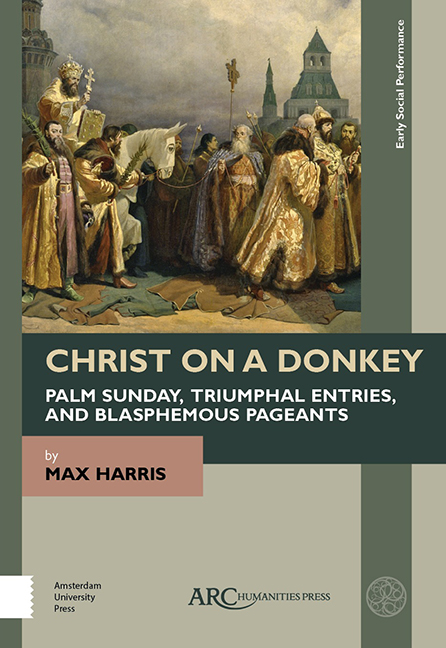14 - An Image of the Lord Seated on an Ass
Published online by Cambridge University Press: 20 November 2020
Summary
SOME TWO HUNDRED years after Charlemagne rode into Rome in conscious evocation of Christ's entry into Jerusalem and some five hundred years before a live donkey was first ridden in a Palm Sunday procession, a carved wooden “image of the Lord seated on an ass” took part in the annual Palm Sunday procession in Augsburg. The palmesel, as such images came to be known, was a major innovation. Other processional images were carried high above the eye level of those who venerated them, but palmesels were mounted on wheels and pulled at street level, enjoying an unconventional intimacy with those around them. It was possible to make eye contact with the figure of Christ on a palmesel— or even for children to ride behind Christ on the donkey— in a way that was unthinkable with a dignitary mounted on a white horse.
I have argued in earlier chapters that Christ's entry into Jerusalem on a donkey was a repudiation of both Jewish and Roman military triumphs, but that many elite Palm Sunday processions and triumphal entries after the time of Charlemagne, in contrary fashion, evoked Christ's entry to display a militant triumphalism. If Christian Europe produced any enduring Palm Sunday processional tradition that resisted this dissonance, it was that of the palmesel. In Part 3.2, I tell the story of the palmesel from its first appearance in tenth-century Augsburg, through its persecution by sixteenth-century Protestant iconoclasts and its suppression by “enlightened” eighteenth-century Roman Catholic prelates, to its survival and even revival not only in Germany and its immediate neighbours, but as far away as lowland Bolivia.
I thus spend more time on palmesels than on royal entries, triumphal Palm Sunday processions, or even live donkeys. I do so for several reasons. First, others have written at length about royal entries and the processional liturgy of Palm Sunday, but no one has written a performance history of palmesels. Second, palmesels were more popular and, in small towns and rural communities, more widespread than royal entries and elite Palm Sunday processions. Third, palmesels play a much larger part in the history of the processional theatre of Palm Sunday than do live donkeys. Fourth, it is worth showing that the form of processional theatre most compatible with the biblical narrative of Christ's entry into Jerusalem was also the most subject to persecution, not by followers of other religions but by zealous Christians.
- Type
- Chapter
- Information
- Publisher: Amsterdam University PressPrint publication year: 2019



